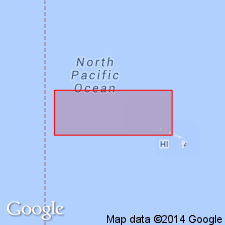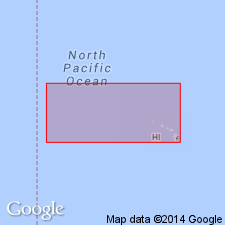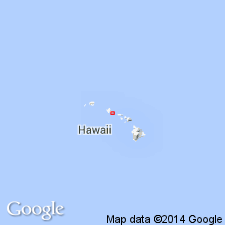
- Usage in publication:
-
- Kaupo basalt*
- Modifications:
-
- Named
- Dominant lithology:
-
- Basalt
- AAPG geologic province:
-
- Oahu
Summary:
Named for occurrence at Kaupo, site of abandoned Hawaiian village at foot of Pali, 200 ft above sea level [Koko Head 7.5' quad, Island of Oahu, HI]. Included as unit in upper part of Honolulu volcanic series. Ocean is shallow between site and Kaohikaipu Island which suggests 2 flows were connected above sea level. Basalt under microscope shows mixed felty and ophitic texture and prominent olivine crystals in groundmass of feldspar, pyroxene, and magnetite. Surface only sparsely covered with soil neither Manana tuff nor reef is present. Kaohikaipu and Kaupo flows are believed to be same age, latest Pleistocene or Recent, based on stratigraphic relations.
Named for occurrence at Kaupo, site of abandoned Hawaiian village at foot of Pali, 200 ft above sea level, [in vicinity of Lat. 21 deg. 18 min. 48 sec. N., Long. 157 deg. 39 min. 56 sec. W., Koko Head 7.5-min quadrangle, Honolulu Co.], Island of Oahu, HI.
[Additional locality information from
Source: GNU records (USGS DDS-6; Menlo GNULEX).

- Usage in publication:
-
- Kaupo basalt*
- Modifications:
-
- Overview
- AAPG geologic province:
-
- Oahu
Summary:
Is lava flow of olivine basalt pahoehoe that issued from talus at foot of great windward cliff of Koolau Range 200 ft above sea level and flowed to ocean. Small heap of spatter marks vent. Forms small peninsula with area of 0.1 sq mi 1 mi NW of Makapuu Head. No fossils. Absence of emerged reef indicates later than Waimanalo stand of sea. Absence of Manana tuff suggests later than Manana tuff cone. Assigned latest Pleistocene or Recent age.
Source: GNU records (USGS DDS-6; Menlo GNULEX).

- Usage in publication:
-
- Kaupo lava
- Modifications:
-
- Geochronologic dating
- AAPG geologic province:
-
- Oahu
Summary:
K-Ar ages on basanitoid samples from Kaupo lava in Honolulu Volcanic Series range from 33 +/-3 ka to 31 +/-5 ka.
Source: GNU records (USGS DDS-6; Menlo GNULEX).

- Usage in publication:
-
- Kaupo Basalt†
- Modifications:
-
- Abandoned
- AAPG geologic province:
-
- Oahu
Summary:
Kaupo Basalt (Stearns, IN Stearns and Vaksvik, 1935) abandoned as formally named unit and called Kaupo flow (and associated conelet), informal unit of Honolulu Volcanics.
Source: GNU records (USGS DDS-6; Menlo GNULEX).
For more information, please contact Nancy Stamm, Geologic Names Committee Secretary.
Asterisk (*) indicates published by U.S. Geological Survey authors.
"No current usage" (†) implies that a name has been abandoned or has fallen into disuse. Former usage and, if known, replacement name given in parentheses ( ).
Slash (/) indicates name conflicts with nomenclatural guidelines (CSN, 1933; ACSN, 1961, 1970; NACSN, 1983, 2005, 2021). May be explained within brackets ([ ]).

